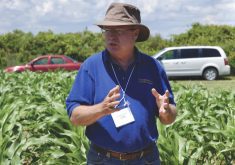When new transgenic and herbicide-tolerant technologies arrive, they come with learning curves, some steeper than others. For Bt corn hybrids, for example, the curve was relatively flat, even if there had to be some serious thinking that about refuge planting. And in glyphosate- and glufosinate-tolerant soybean varieties, there may have been initial concerns about having to sign special contracts, but the job in the field was quite straightforward.
But the new glyphosate-dicamba-tolerant technologies and their associated chemical treatment products have generated more than their share of complications since their launch. In many ways it’s an old problem cloaked in a new issue.
Read Also

Agronomists share tips for evaluating new crop products and tech: Pt. 3
With new products, new production practices and new technology converging on the agriculture industry at a frenetic pace in recent…
In 2015, Genuity, a division of Monsanto, used Canada’s Outdoor Farm Show to showcase the arrival of the Roundup Ready Xtend crop system and Roundup Ready 2 Xtend soybeans. It was heralded as a triumph in the fight against weed species that had selected for resistance to glyphosate.
The big difference with that campaign three years ago was the painstaking detail that Monsanto went through in explaining the conditions under which the Xtend technology — including XtendiMax, the glyphosate-dicamba blend — could be used.
At the time of the Xtend system introduction, North American growers were learning to deal with the sensitive nature of the new chemical blend. Reports out of the U.S. told of widespread damage to crops that were not part of the Xtend cropping systems, largely because growers were defaulting to applications of older dicamba formulations.
Much of the problem was attributed to the U.S. Environmental Protection Agency (EPA) approval of the Xtend cropping systems but not for XtendiMax (or its BASF counterpart, Engenia). The result was a surge of lawsuits and investigations in various parts of the U.S.
Old problem, new issue
In Canada, the perception was that farmers had escaped the legal battles because the Pest Management Regulatory Agency (PMRA) had approved the Xtend cropping system and XtendiMax, thus alleviating the issue of off-target movement of herbicide applications. The information and awareness campaigns — similar to the ones held at the 2015 Outdoor Farm Show — and the simultaneous registrations had done their respective jobs.
Unfortunately, in many cases in Canada, it’s come down to the need to manage drift in a more sensitive environment.
Chad Anderson is an Ontario independent certified crop adviser (CCA) from Brigden, just south of Sarnia. During the course of the 2017 growing season, he spent a considerable amount of his time investigating damage claims on behalf of insurance companies.
Ironically, he believes the claims came in large part because there were no issues in 2016, which may have made some who were using the technology a little complacent the following year. The 2018 growing season has seen a few more issues as soybean growers are adapting the technology on a broader basis.
“We’ve always had to manage our spray operations for drift but the introduction of the Xtend technology has heightened awareness as non-Xtend soybeans are ultra-sensitive to dicamba,” says Anderson. “In the past, you could drift the same amount of a different chemistry and not see any damage, like spraying glyphosate on your Roundup Ready crop while your neighbour had conventional soybeans. Unfortunately, there were also instances where sub-lethal doses of glyphosate were applied near a sensitive crop like field tomatoes. In those cases, the tomatoes may have looked undamaged but they failed to properly ripen at harvest. So no matter what your product, you must always be on guard for off-target conditions when applying pesticides.”
Changing landscape
In spite of the many challenges of using Group 4 chemistries like dicamba and 2,4-D blended with glyphosate, Anderson emphasizes that the Xtend technology system provides superior weed control compared to anything currently on the market. It’s also being released in the highest-performing soybean varieties, so growers are going to end up with the opportunity to use dicamba regardless of whether or not they actually intend to spray it.
“I work for clients who grow the genetics, have the proper coarse sprayer tips but won’t apply the new products as they’re scared of spraying dicamba,” says Anderson. “They want the high-yielding genetics and in part use the technology to protect themselves from neighbouring drift. As time goes on, though, there’ll be a temptation to adopt the full use of the technology, given how well it does work when properly applied.”
On the other side of the herbicide spectrum, he acknowledges the shortcomings of the Group 4 herbicides. It’s now more noticeable, for instance, how wild carrot is becoming a problem in some fields where growers are using dicamba or 2,4-D in their burndowns. At the same time, there is research on the use of a Group 5 (metribuzin) in soybeans for added control of Canada fleabane.
But the message remains the same. Gone are the days of rotating from corn to soybeans and hoping that a single-use application of glyphosate will control weeds. That message has to be repeated, seemingly every year.
Tank cleanouts and increasingly complex logistics add another layer of challenges to weed management and herbicide usage. Then there’s the growing need to know precisely what crops your neighbours have planted. Today, perhaps more than ever, farmers are being watched in all facets of what they do. That’s why weed management in this changing technology and herbicide landscape is no longer a simple matter.
“We’ve shown that we can manage glyphosate resistance without the technology through good crop rotations and tank-mix partners,” says Anderson. “Dicamba is certainly the simplest answer as well as the most flexible in terms of use, but I really think it’s a matter of the better genetics introducing the technology on the farm — and that will be the driving force behind growers looking at this new herbicide option.”
The use of dicamba certainly raises the bar on application skills. Farmers or applicators must pay greater attention to the label, understand their surroundings and be aware of sensitive crops in neighbouring fields. Just because an operator is using low-drift tips on the spray doesn’t mean growers can let down their guard. Wind direction and speed can change with little or no warning, and those are just two of the parameters that can lead to a mess.
The right spray tips, the right water volumes, ground speeds and ambient weather conditions each play a role.
“Of dicamba off-target drift events that I investigate, 90 per cent are due to off-label use and operator error,” says Anderson. “I remember impressing an old mentor of mine when I told him that people who drift on to other’s crops are selfish — that they see their own crops as being more important than their neighbour’s. People just need to follow the label and make this technology work.”
This article was originally published in the October 2018 issue of the Soybean Guide.
















